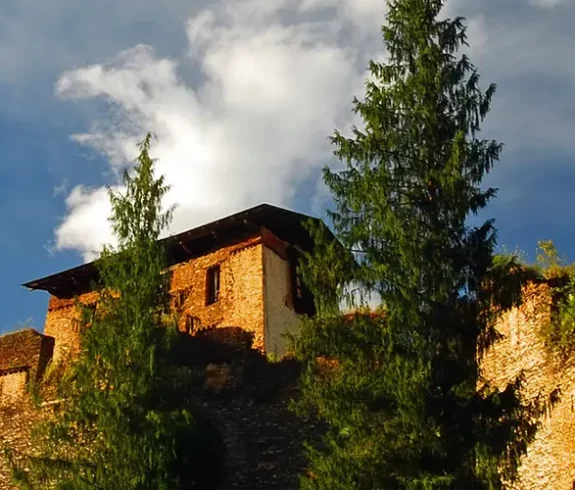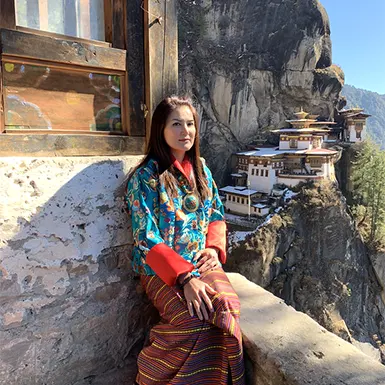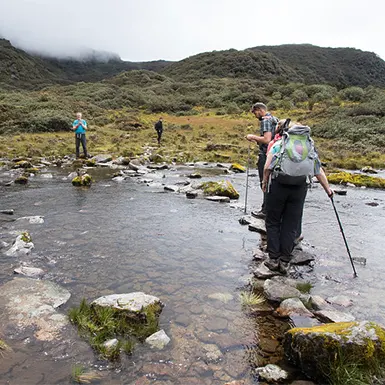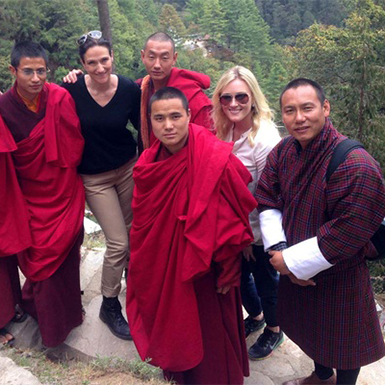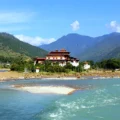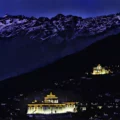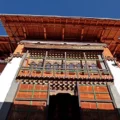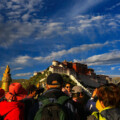High in Bhutan’s awe-inspiring Paro Valley, the remnants of Drukgyel Dzong stand tall, a living testament to the nation’s vibrant past and unyielding spirit. This fortress, built in the 17th century, was a formidable stronghold and a beacon of defense against invaders. Today, its weathered stones whisper tales of epic battles and cultural resilience, transporting visitors to a time of legends. Known as the “Fortress of the Victorious Drukpas,” Drukgyel Dzong holds a revered place in Bhutanese hearts as a symbol of triumph and an irreplaceable piece of their heritage.
Why Should Drukgyel Dzong Be on Your Bhutan Itinerary?
- A Tribute to Victory: Bhutanese forces erected Drukgyel Dzong in 1649 to celebrate their victory over invading Tibetan armies. Its name, a combination of “Druk” (the Bhutanese name for their country) and “gyel” (victory), embodies its role as a monument to national pride.
- Architectural Masterpiece: Even in its ruined state, the fortress showcases the exceptional craftsmanship of Bhutanese architecture. Intricate wooden carvings, imposing stone walls, and timeless design elements continue to impress, having endured centuries of wear and tear.
- Nature’s Canvas: Nestled in the Paro Valley, the Dzong commands breathtaking vistas of the surrounding mountains and landscapes, adding to its undeniable charm.
- Cultural Touchstone: Drukgyel remains deeply interwoven with Bhutanese culture, a constant reminder of the nation’s unwavering spirit and determination.
- Photographer’s Haven: The Dzong’s picturesque ruins and dramatic backdrop provide a visual feast for photographers, offering endless opportunities to capture stunning images.

Drukgyel Dzong: Where Bhutan’s History Comes Alive
Unearthing the Past: The Story of Drukgyel Dzong
Drukgyel isn’t merely a collection of weathered stones; it’s a living testament to Bhutan’s unwavering resilience. Zhabdrung Ngawang Namgyal, the architect of a unified Bhutan, commissioned its construction in 1649 as a symbol of triumph over invading Tibetan forces and a deterrent against future attacks.
Guardian of the Paro Valley
The fortress’s strategic location in the Paro Valley was no accident. It stands as a sentinel, a formidable barrier against any incursion from the north. The Dzong’s imposing walls, watchful towers, and labyrinthine secret passages showcase the ingenuity of military engineering at the time.
Moments in History
- 1644 Tibetan Invasion: The impetus for building Drukgyel was the 1644 Tibetan invasion. The Bhutanese, led by Zhabdrung Ngawang Namgyal, triumphantly repelled the invaders, forever altering the course of Bhutan’s history.
- The Battle of Five Lamas (1634): Although not directly tied to Drukgyel Dzong, this prior conflict solidified Bhutan’s independence from Tibet and set the stage for the fortress’s eventual creation.
- The Dzong’s Protective Role: It remained an active bastion of defense, shielding Bhutan from further Tibetan aggression for centuries. Its strategic vantage point and imposing architecture embodied national security.
A Legacy of Resilience
A devastating fire in 1951 ravaged much of Drukgyel, but its significance has never waned. Restoration efforts have revitalized the fortress, inviting visitors to walk through history and imagine the echoes of battles fought long ago. It holds a sacred place in the hearts of the Bhutanese, who revere its role in safeguarding their homeland.
Unveiling Architectural Wonders: A Look Inside Drukgyel Dzong
Even with parts in ruins, Drukgyel Dzong is a testament to Bhutan’s architectural brilliance. The design is a beautiful fusion of aesthetics and function, reflecting the country’s unique culture and strategic defense capabilities.
A Walk Through Time: The Architectural Features
- Towering Walls: The Dzong’s thick, whitewashed walls, constructed from rammed earth and stone, stand defiant against the elements. They once formed an impenetrable barrier with strategically placed openings for archers and defenders.
- Sentinel Towers: Several watchtowers, some reaching three stories high, commanding panoramic views of the surrounding valley. These towers served as vigilant lookouts, enabling defenders to spot approaching threats from a distance.
- Intricate Wood Carvings: Inside the Dzong, you’ll discover intricate wooden carvings adorning doors, windows, and ceilings. These carvings often portray religious symbols, mythological figures, and scenes from everyday Bhutanese life.
- Central Tower (Utse): A defining characteristic of Bhutanese Dzongs, the central tower or “Utse” typically housed the main temple and served as a last line of defense during sieges.
- Open Courtyards: Spacious courtyards within the Dzong provided areas for gatherings, ceremonies, and daily activities. They also facilitated air circulation and allowed natural light to filter in.
A Fortress Designed for Defense
Strategists carefully crafted Drukgyel Dzong’s layout to optimize its defensive capabilities, incorporating key features such as:
- Narrow Entrances: Multiple entrances, some intentionally deceptive, were designed to confuse and trap invading forces.
- Hidden Passages: Secret passages woven within the walls allowed defenders to move discreetly and launch surprise attacks.
- Multi-Level Design: The Dzong’s multi-level structure offered varied vantage points for archers and defenders, making it difficult for attackers to gain the upper hand.
- Defensive Openings (Machicolations): These wall openings allowed defenders to rain down stones or other projectiles on attackers below.
Lost and Found Treasures
Before the disastrous fire in 1951, it safeguarded priceless artifacts and relics. While the flames consumed many treasures, some notable items survived:
- Sacred Statues: Bronze statues of Buddhist deities, such as Guru Rinpoche and Chenrezig, were common in Dzongs and served as objects of reverence.
- Ancient Weapons: Swords, spears, and other 17th-century weapons may have been stored within the Dzong, showcasing the era’s military prowess.
- Religious Texts: Valuable manuscripts and scriptures, often housed in the use, would have been essential for spiritual practices and scholarly pursuits.
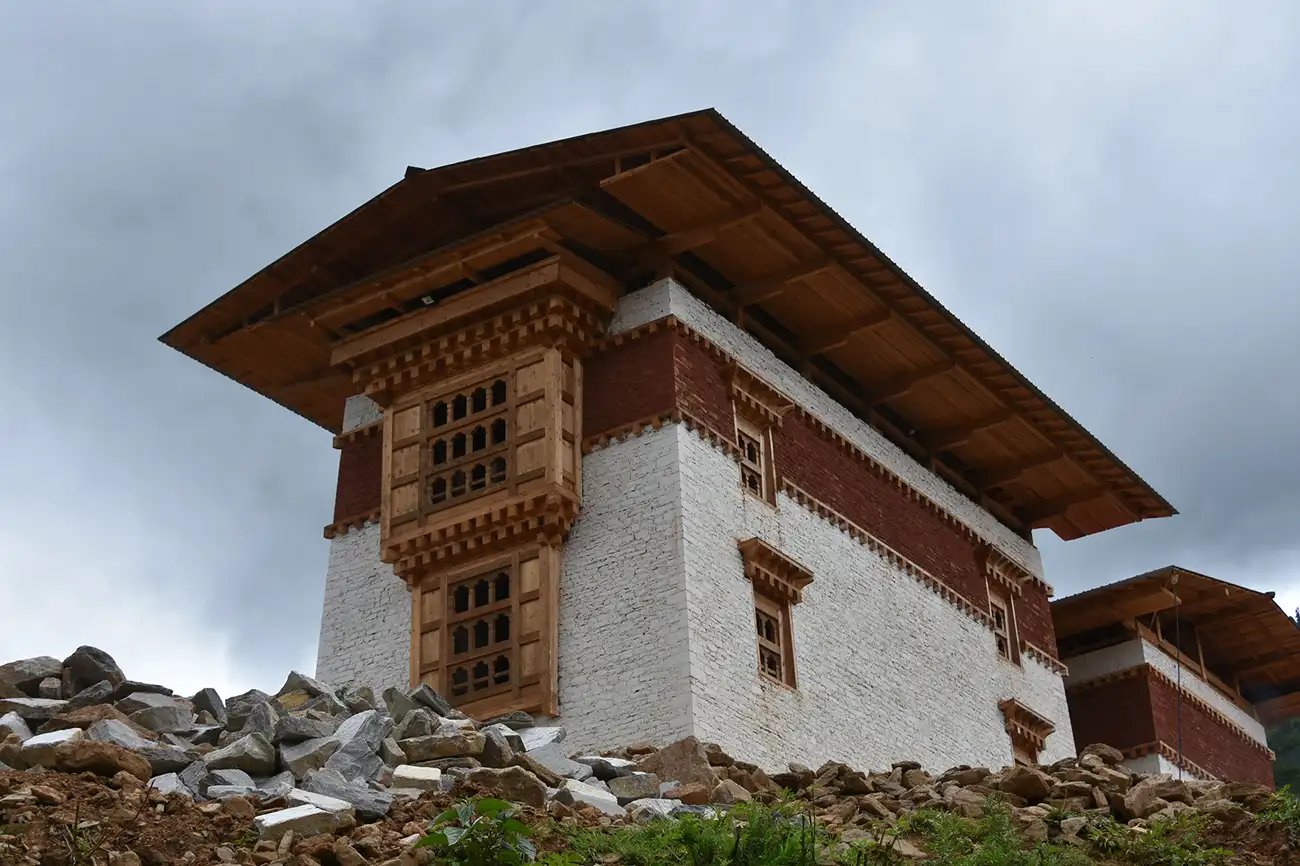
A Turning Point in History: The 1951 Fire
In 1951, tragedy struck Drukgyel Dzong. A devastating fire, likely accidental, swept through the fortress, reducing much of its intricate woodwork and interior structures to ashes. This unfortunate event left the Dzong in ruins for several decades, marking a significant turning point in its history.
Reviving a National Treasure: Restoration Efforts
The Bhutanese people deeply revere Drukgyel, and its restoration has been a labor of love. In 2016, on the command of His Majesty the King, a comprehensive restoration project began to preserve the remaining structures and rebuild lost elements to their original splendor.
Collaborative Restoration
The restoration of Drukgyel Dzong has been a collaborative effort involving:
- The Bhutanese Government: The government has played a pivotal role in funding and overseeing the project, ensuring it adheres to traditional architectural principles and techniques.
- International Organizations: Due to the Dzong’s cultural and historical significance, organizations like UNESCO have expressed interest in supporting the restoration.
- Skilled Artisans: Bhutanese artisans, renowned for their craftsmanship, have meticulously recreated intricate woodwork, murals, and other decorative elements based on historical records and photographs.
- Local Community: The Paro Valley community has actively participated in the restoration, contributing their knowledge and skills to the project.
Restoration Challenges and Progress
Restoring a centuries-old fortress is a challenging feat. Challenges have included:
- Maintaining Authenticity: Ensuring that the restoration accurately reflects the original design and materials of the Dzong.
- Sourcing Materials: Finding traditional building materials, such as specific types of wood and stone, has required extensive research and effort.
- Logistical Challenges: The remote location of the Dzong has presented logistical hurdles in transporting materials and equipment.
Despite these challenges, the restoration team has made significant progress. They have stabilized the main structures, replicated intricate woodwork, and restored many of the Dzong’s original features.
A Symbol of Resilience
The restoration of Drukgyel transcends mere preservation; it embodies Bhutan’s resilience and unwavering dedication to safeguarding its cultural heritage. It represents the enduring spirit of the Bhutanese people, who have come together to rebuild this iconic fortress, ensuring that future generations can appreciate its historical and architectural significance.
More Than Stones and Mortar: Drukgyel Dzong’s Cultural and Spiritual Heart
Drukgyel Dzong isn’t just a historical monument; it’s a vibrant tapestry of Bhutanese culture and spirituality. The Dzong weaves the threads of faith and defense, where legends intertwine with history.
A Beacon of Bhutanese Culture
- Pilgrimage Destination: For centuries, the Bhutanese have revered Drukgyel Dzong as a sacred pilgrimage site. They tour here to honor the protective deities believed to dwell within its walls and seek blessings for their well-being.
- Symbol of Unity: The Dzong embodies the unity of the Bhutanese people, who once united to defend their homeland from invaders. It serves as a powerful reminder of their shared history and cultural identity.
- Cultural Celebrations: The Dzong has hosted many cultural events and festivals. These celebrations often feature vibrant masked dances, traditional music, and religious rituals, offering a captivating glimpse into the richness of Bhutanese traditions.
Festivals That Ignite the Spirit
- Druk Wangyel Tshechu: This annual festival, held near Drukgyel Dzong, honors the Bhutanese victory over Tibetan invaders in the 17th century. Masked dancers reenact historic battles and pay tribute to the nation’s heroes.
- Local Tshechus: Throughout the year, smaller tshechus (religious festivals) occur at the Dzong, each with unique rituals and celebrations.
Whispers of Legends and Folklore
It is steeped in legends and folklore passed down through generations. Some of the most notable stories include:
- Zhabdrung’s Prophecy: Legend tells that Zhabdrung Ngawang Namgyal, the unifier of Bhutan, foresaw the construction of Drukgyel as crucial to repelling Tibetan invasions.
- Guardian Deities: Locals believe powerful deities protect the Dzong, watching over the Paro Valley and its people. Visitors often leave offerings and prayers at the Dzong to seek their blessings.
- The Hidden Treasure: Whispers of hidden treasure buried within the Dzong’s walls, which ancient kings and warriors left behind, add to its mystique.
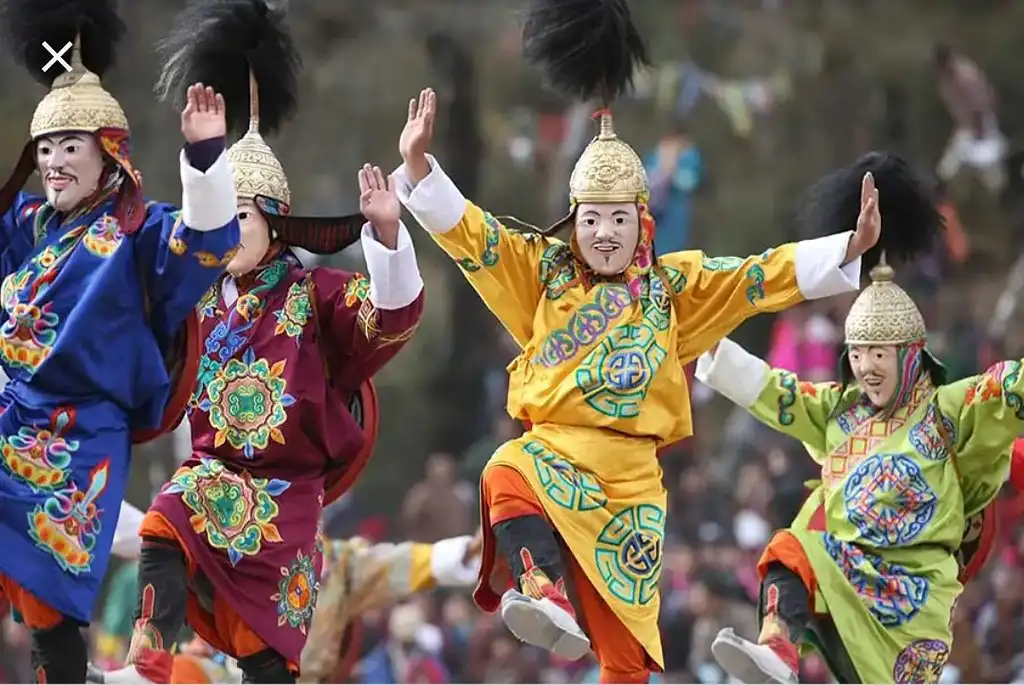
Uncover the Magic of Drukgyel Dzong: A Visitor’s Guide
Visiting Drukgyel Dzong is more than a sightseeing trip—it’s stepping back in time. Here’s what you can experience at this sacred and scenic site:
Guided Tours: Unveiling the Past
- Passionate guides lead you through the ruins, weaving captivating tales of past battles, triumphs, and the Dzong’s cultural importance.
- You’ll discover intricate architectural details, the strategic layout, and insights into the daily life of the Dzong’s former inhabitants.
- Feel free to ask questions to enhance your knowledge of Bhutanese history, traditions, and the significant role of Drukgyel in shaping the nation’s identity.
Scenic Splendor: A Photographer’s Paradise
- Marvel at the majestic Mount Jomolhari, a sacred peak that dominates the horizon with its snow-capped summit piercing the clouds.
- Savor the panoramic views of the vibrant Paro Valley, adorned with terraced fields, winding rivers, and traditional Bhutanese farmhouses.
- Capture postcard-worthy photos of the Dzong’s ruins against the breathtaking backdrop of mountains and valleys.
Immerse Yourself in Unique Experiences
- Wander Through History: Roam through the maze-like corridors, ascend ancient stairways, and peek into chambers that once bustled with activity. Imagine the echoes of the past as you explore these timeworn walls.
- Unravel Military Tales: Learn how Drukgyel Dzong was pivotal in defending Bhutan from invasion. Discover how the fortress’s clever design and the courage of its defenders preserved the nation’s independence.
- Cultural Encounters: You might encounter local pilgrims offering prayers and rituals at the Dzong, providing a unique opportunity to witness the Bhutanese people’s deep spiritual connection with this sacred site.

Finding Your Way to Drukgyel Dzong: Location and Access
Drukgyel Dzong is a beacon of history in the picturesque Paro Valley, just a short distance from Paro. With several options for reaching the Dzong, your adventure begins before stepping on its hallowed grounds.
Getting There: Your Options
- From Paro Town (14 km): The most convenient option is to hire a taxi in Paro. The tour takes approximately 30-40 minutes, and drivers often share exciting stories and information about the area.
- Taxi: This option offers the most flexibility and comfort, letting you travel at your own pace. Taxis are readily available in Paro town.
- Local Bus: Local buses run between Paro town and Drukgyel. This option is more budget-friendly, but the schedule may be less frequent.
- Guided Tour: Many tour operators offer guided trips to the Dzong, typically including transportation and a knowledgeable guide to enhance your experience.
- Hiking: The adventurous can take a scenic hike from Paro to the Dzong. The hike takes roughly 3-4 hours and rewards you with breathtaking views of the valley. Wear durable hiking boots, carry ample water, and think about hiring a local guide for safety and navigation.
Nearby Attractions to Enrich Your Bhutan Experience
- Ta Dzong (National Museum of Bhutan): Once a watchtower, Ta Dzong is now a museum showcasing Bhutan’s rich cultural heritage through exhibits on art, history, and religion.
- Rinpung Dzong (Paro Dzong): Paro’s administrative and monastic center is this impressive fortress. It is a UNESCO World Heritage site and a must-visit for its stunning architecture.
- Kyichu Lhakhang: One of Bhutan’s oldest and most sacred temples, Kyichu Lhakhang, dates back to the 7th century.
Tips for a Smooth Visit
- Best Time to Visit: Spring (March-May) and autumn (September-November) offer pleasant weather and clear skies, making them ideal times to visit Drukgyel Dzong.
- Permits and Visas: Foreign tourists require a visa to enter Bhutan. Arrange this in advance through a licensed tour operator. The tour operator will also provide the necessary permits to visit Drukgyel.
- What to Pack: Remember to pack comfortable footwear that is ideal for exploration or a brief walkabout. Dress in a manner that allows you to adapt to the weather conditions expected in the area. A hat, sunglasses, and sunscreen should protect you from sunburn. You’ll need a camera if you wish to photograph the awe-inspiring terrain; also, get yourself a reusable water bottle to quench your thirst when you’re out.
Beyond the Fortress: Exploring Paro Valley’s Cultural Gems
Your adventure continues beyond Drukgyel Dzong. The Paro Valley offers a treasure trove of cultural, historical, and natural attractions ready for exploration. Here are some must-see highlights:
- Paro Taktsang (Tiger’s Nest): A breathtaking monastery clinging to a cliffside, Paro Taktsang is an iconic symbol of Bhutan. The hike to the monastery is a rewarding challenge, offering stunning views and a sense of spiritual fulfillment.
- Kyichu Lhakhang: One of Bhutan’s oldest and most sacred temples, Kyichu Lhakhang, dates back to the 7th century. Its tranquil atmosphere and intricate murals make it a serene place for reflection.
- Rinpung Dzong (Paro Dzong): This imposing fortress, a UNESCO World Heritage Site, serves as a monastery and the administrative center for Paro District. Its grand architecture and intricate details are a sight to behold.
- National Museum of Bhutan (Ta Dzong): Housed in a former watchtower, the museum showcases Bhutan’s rich cultural heritage through exhibits on art, history, and religion.
Crafting Your Ideal Itinerary
Here are a couple of suggested itineraries to help you make the most of your time in the Paro Valley:
Option 1: A Cultural Immersion
- Day 1: Arrive in Paro and visit Kyichu Lhakhang and Rinpung Dzong.
- Day 2: Hike to Paro Taktsang (Tiger’s Nest) in the morning. In the afternoon, explore the National Museum of Bhutan.
- Day 3: Visit Drukgyel Dzong and enjoy the scenic drive back to Paro town.
Option 2: History and Hiking
- Day 1: Arrive in Paro and head straight for Drukgyel Dzong.
- Day 2: Begin on the challenging but rewarding hike to Paro Taktsang.
- Day 3: Explore Rinpung Dzong and the National Museum, and stroll through Paro town to soak up the local atmosphere.
Essential Travel Tips for a Meaningful Visit
Plan your visit wisely for a fulfilling experience at Drukgyel. Here’s what you need to know:
The Best Time to Visit Drukgyel Dzong
- Spring (March-May) and Autumn (September-November): These months offer the most pleasant weather for exploring Bhutan, with mild temperatures, clear skies, and vibrant landscapes. December offers a unique cultural experience with the Druk Wangyel Tshechu festival.
- Summer (June-August): During Bhutan’s monsoon season, be prepared for occasional rain showers. The Dzong remains open, but exercise caution on the potentially slippery hiking trails.
- Winter (December-February): Embrace the colder temperatures, especially at higher altitudes. Witness the beauty of snow-capped mountains surrounding the Dzong.
Packing Essentials
- Sturdy Footwear: Pack comfortable and supportive shoes for walking on uneven terrain, especially if you plan to hike or explore the trails around the Dzong.
- Layered Clothing: The temperature can be remarkable at higher altitudes, so dress in layers for easy adaptability. Bring a rain jacket or poncho, particularly during the monsoon season.
- Sun Protection Gear: Remember to underestimate the sun’s intensity at high altitudes, even on cloudy days. Remember your sun defense! Sunglasses, a hat, and sunscreen are your best friends for keeping your skin safe.
- Camera: Capture the captivating scenery of Drukgyel Dzong and the Paro Valley. Remember your camera or smartphone so you can capture unforgettable moments and sights.
- Hydration Essentials: Staying hydrated is crucial, especially during hikes. Stay eco-friendly and quench your thirst throughout the day with a refillable water bottle.
- Daypack: A compact backpack is your best friend. It allows you to easily carry essentials like water, snacks, a map, and an extra layer for changing weather.
Show Respect at Sacred Sites
- Dress Respectfully: Bhutanese culture values modesty. Dress in attire that covers your shoulders and knees, particularly when visiting temples or religious areas within the Dzong.
- Ask Permission Before Photographing: As a gesture of respect, always seek permission before photographing locals, especially monks and nuns.
- Remove Your Shoes: Please remove your shoes before entering any temple or religious building to show respect.
- Maintain a Serene Atmosphere: Keep your voice low and respect the tranquility of the Dzong’s sacred spaces.
- Hands-Off Artifacts: Avoid touching or climbing on ancient structures or artifacts, as they are delicate and hold cultural significance.
Drukgyel Dzong: A Bhutanese Treasure Worth Discovering
Drukgyel Dzong is a living testament to Bhutan’s rich history, enduring culture, and architectural ingenuity. Walking among its weathered walls, you’ll sense the echoes of ancient battles and the unwavering spirit of a nation. From its strategic perch in the Paro Valley to its intricate design and breathtaking panoramas, it offers a captivating experience for every traveler. Here’s Why Drukgyel Dzong Should Be on Your Bucket List:
- A Monument to Triumph: Bhutan takes immense national pride in Drukgyel, commemorating a pivotal victory over Tibetan invaders.
- Architectural Marvel: Even in its ruined state, the fortress showcases the exceptional craftsmanship of Bhutanese artisans, evident in its imposing walls and intricate woodwork.
- Cultural Touchstone: Bhutanese people cherish the Dzong as a pilgrimage site and a living testament to their cultural heritage.
- Nature’s Masterpiece: The surrounding Paro Valley offers stunning views of Mount Jomolhari and a serene landscape perfect for quiet contemplation.
- Renewed Glory: Ongoing restoration work ensures that future generations can appreciate the Dzong’s beauty and historical significance.
Don’t Just Read About It – Experience It!
Drukgyel Dzong is more than just a historical site; it’s a portal to another time. Plan your visit, uncover the stories etched in its stones, and become a part of the vibrant tapestry of Bhutanese culture. As you admire the majestic mountains and wander through the ancient ruins, you’ll create memories that will last a lifetime.
